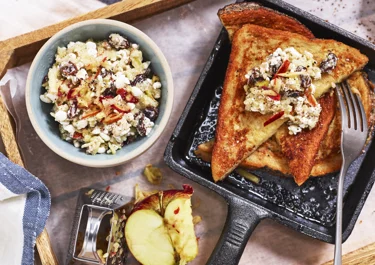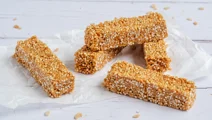Protein french toast with cottage cheese

Kickstart your day with our protein French toast, a luxurious twist on a breakfast classic. This recipe blends the richness of eggs, creamy texture of cottage cheese and smoothness of milk to create a luxurious meal. Infused with warm hints of cardamom and vanilla, it strikes the ideal balance of flavour and texture. Juicy apples and sweet raisins add a natural touch of sweetness, making each bite a truly decadent way to begin your morning.
Ingredients
|
Eggs
|
3 |
|---|---|
|
Milk
|
200 ml |
|
Cardamom, ground
|
½ tsp |
|
Salt
|
2 pinches |
|
Apple
|
1 |
|
Cottage cheese
|
150 g |
|
Raisins
|
30 g |
|
Vanilla powder
|
1 pinch |
|
Bread, thick slices
|
4 slices |
|
Butter
|
3 tbsp |
Instructions
Get the texture just right
Perfecting the soft, luxurious texture that makes French toast so irresistible requires a few key techniques. For a custardy centre with a crisp, golden-brown exterior, soak the bread just enough to absorb the egg mixture without becoming too soggy. Using thicker slices helps the bread maintain its structure, staying firm yet tender after soaking and cooking. Frying over a gentle, even heat allows the toast to cook through without turning tough, resulting in beautifully textured French toast with a creamy, flavourful middle and a perfectly caramelized crust.
Whisk for frothiness and even coating
For the best results, begin by whisking the egg mixture until it’s light and slightly frothy. This not only fully combines the ingredients but also incorporates a bit of air, allowing the bread to soak up the mixture evenly. A well-whisked egg base clings to the bread without pooling, creating a uniform coating that cooks to a beautiful golden colour. Use a fork or a small whisk, ensuring there are no clumps before dipping the bread. This step is essential for coating each slice in the custard-like mixture, resulting in a smooth, even texture.
Prevent your protein French toast from sticking
Start by heating a non-stick or well-seasoned frying pan with a small amount of butter. Adding the bread only once the pan is hot allows the surface to sear quickly, helping the toast lift off easily. Avoid overcrowding the pan as this can cause the bread to stick and lead to uneven cooking. If you’re making multiple batches, wipe out the pan and re-grease lightly between rounds to maintain that smooth, non-stick surface. These small steps will ensure hassle-free flipping and beautiful browning.
FAQ: Questions about protein French toast
Unlock the secrets to a consistently perfect serving of protein French toast, every time. We answer your top questions to help you pick the best bread, reheat with skill and make this dish a staple in your breakfast routine. Discover how to get that ideal texture and know when your French toast is ready to enjoy.
What type of bread works well for this recipe?
How long should I soak the bread?
How do I know my protein French toast is done?
Nutritional values
Nutritional value, per
973 Kcal
| Fibre | 9.9 gram fibers |
| Protein | 39.7 |
| Carbohydrates | 102.5 |
| Fat | 44.7 gram |
Meal prep for easy mornings
This recipe is a fantastic meal-prep option that can be made ahead for easy breakfasts. After cooking, let the slices cool completely, then layer with parchment paper in an airtight container. Store in the fridge for up to three days. When you’re ready to eat, simply reheat in a skillet or toaster to bring back the toast’s delicious flavour and texture.
Pair your breakfast with other make-ahead options like protein muesli, protein overnight oats or protein breakfast bars, offering a convenient, stress-free way to get your day going. Keep in mind that, when pairing your protein French toast with other dishes, it may change this recipe’s nutritional values, including its protein content.
Optimal reheating for lasting freshness
To reheat with the best possible texture, use a toaster or hot frying pan rather than a microwave. This will help re-crisp the outer edges, bringing back that freshly made feel. If using a frying pan, heat it over medium-low and cook each slice for about a minute on each side. Avoid overheating, as this can make the toast dry.
Is this recipe suitable for freezing?
Yes, this is an ideal recipe to prepare in advance for quick breakfasts or snacks. Once the toast has cooled, arrange the slices on a baking sheet to freeze individually. After they’re frozen, transfer the slices to a freezer-safe bag or container, where they’ll keep for up to three months. To reheat, pop the frozen slices in a toaster, or warm them in a frying pan on low heat.
Toast the bread for a crispier edge
For an extra-crispy edge, try toasting the bread lightly before soaking it in the egg mixture. Pre-toasting gives it a slightly firmer texture, which not only holds up better during soaking but also creates a lovely contrast between the crispy edges and soft centre once cooked. To toast, simply place the slices in a toaster or under the grill for a few minutes until just firm, then proceed with the recipe as usual.






